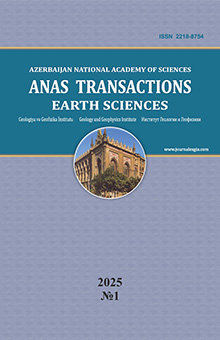№ 2,
2020
Download the article
Division of the geological section into homogeneous drillability intervals based on the results of modeling the properties of rocks in the drilling process
Institute of Oil and Gas of Azerbaijan National Academy of Sciences 9, F.Amirov str., Baku, AZ1000, Azerbaijan: igorbaku@yandex.ru
Summary
A-
A+
Improving the efficiency and quality of well drilling largely depends on improving the quality of information received. The quality of decisions made during drilling also substantially depends on the quality of information. Widely used in recent years in world practice, mud logging in the process of drilling allows us to solve a number of problems in the drilling process, when information about the section of the well being drilled is missing or is available in a limited amount. The application of the results of the complex of geological, geophysical and technological research allows us to study more deeply the section and thereby improve the quality of decisions.
The article discusses ways to improve the quality of information and obtain more extensive information about the drilled rock, which allows us to divide the section into homogeneous intervals. For this purpose, an approach known from fuzzy logic was applied to find the appropriate criterion for each of the indicators under consideration, and then their average harmonic value was calculated. The relationship between the mean harmonic value and the depth serves to define the boundaries between the intervals. The above algorithm was used for calculations for four wells in the Bahar field, and the results were clearly demonstrated using figures.
The article discusses ways to improve the quality of information and obtain more extensive information about the drilled rock, which allows us to divide the section into homogeneous intervals. For this purpose, an approach known from fuzzy logic was applied to find the appropriate criterion for each of the indicators under consideration, and then their average harmonic value was calculated. The relationship between the mean harmonic value and the depth serves to define the boundaries between the intervals. The above algorithm was used for calculations for four wells in the Bahar field, and the results were clearly demonstrated using figures.
Keywords: complex information, geological section, rock, bit, complications, classification, decision-making, uncertainty, fuzzy logic
REFERENCES
Aghayev S.G. A systematic approach to improving the efficiency of well drilling. Abstract of doctoral dissertation, Baku, 1989, 52 p. (in Russian).
Brown D.F., Cuddy S.J., Garmendia-Doval A.B., McСall J.A.W. The prediction of permeability in oil-bearing strata using genetic algorithms. In: Materials of the Third IASTED International Conference Artificial Intelligence and Soft Computing, Banff, Alberta, Canada, July 24-26, 2000, https://www.researchgate.net/publication/220909228_ The_Prediction_of_Permeability_in_Oil-Bearing_Strata_ using_Genetic_Algorithms.
Cuddy S.J., Glover P.W.J. The application of fuzzy logic and genetic algorithms to reservoir characterization and modeling. Soft Computing for Reservoir Characterization and Modeling, No. 1, 2002, pp. 219-241.
Delia S.V., Rakitin M.V. Development tendencies of drilling’s geology-technological and geophysical surveys. Drilling and oil, No. 2, 2014, http://naukarus.com/tendentsii-razvitiya-gti-i-gis-bureniya (in Russian).
Dyusenov A.T. Improving the efficiency of well drilling by choosing the optimal combination of types of bits and technological parameters. PhD Thesis, Atyrau, 2008, 23 p. (in Russian).
Dzhanzakov I.I., Piriverdiyev I.A., Gulizadeh K.P. et al. Analysis of the state of decision-making methods and tools for drilling wells using integrated geological and technological information. Equipment and technologies for the oil and gas complex, Vol. 111, No. 3, 2019, pp. 51-59 (in Russian).
Efendiyev G.M., Djafarova N.M., Djevanshir R.D. The optimum decision in cutting-type drilling bits selection with regard to their operating conditions and the vagueness of the task posed. Energy sources, Vol. 13, No. 2, 1991, pp. 243-250.
Efendiyev G.M., Kuliyev H.H., Piriverdiyev I.A. et al. Methods and tools to improve the quality of information in decision making in well drilling management. Collection of scientific papers: rock destruction and metalworking tools – techniques and technology for their production and use. Kiev, V.N.Bakul Institute for superhard materials, Vol. 22, 2019, pp. 52-62 (in Russian).
Efendiyev G.M., Mammadov P.Z., Piriverdiyev I.A. Modeling and evaluation of rock properties based on integrated logging while drilling with the use of statistical methods and fuzzy logic. 10th International Conference on theory and application of soft computing, computing with words and perceptions – ICSCCW-2019. Advances in intelligent systems and computing book series (AISC), Vol. 1095, 2019, pp. 503-511.
Efendiyev G.M., Mammadov P.Z., Piriverdiyev I.A., Sarbopeyeva M.D. Selection of the best combination of bit types and technological parameters during drilling, taking into account uncertainty. Procedia computer science, Vol. 120, 2017, pp. 67-74.
Mirzadzhanzadeh A.Kh., Aghayev S.G., Alimammadov A.F. et al. Guidance on the application of the mathematical theory of the experiment to the study of rock properties and the process of their destruction. Nedra. Moscow, 1973, 98 p. (in Russian).
Rakitin M.V. Problems and prospects of using the GTI and GIS-drilling (LWD) based on the experience of drilling production wells on the North Caspian shelf. Drilling and oil, No. 07-08, 2015, https://burneft.ru/archive/issues/2015-07-08/26 (in Russian).
Rodionov D.A. Statistical methods of distinguishing geological objects by a set of features. Nedra. Moscow, 1968, 158 p. (in Russian).
Taylor T.R., Kittridge M.G., Winefield P.L. et al. Reservoir quality and rock properties modeling results – Jurassic and Triassic sandstones: Greater Shearwater Area, UK Central North Sea. Marine and Petroleum Geology, Vol. 65, 2015, pp. 1-21.
Wawrzyniak-Guz K. Rock physics modelling for determination of effective elastic properties of the lower Paleozoic shale formation, North Poland. Acta Geophysica, Vol. 67, 2019, pp. 1967-1989.
Wang Z., Wang R., Li T., Schmitt D.R. Modelling of viscoelastic properties of porous rocks saturated with viscous fluid at seismic frequencies at the Core Scale. Workshop: Rock physics and borehole geophysics, Beijing, 28-30 August 2016, https://library.seg.org/doi/abs/10.1190/RP2016-003.
DOI:
10.33677/ggianas20200200044
